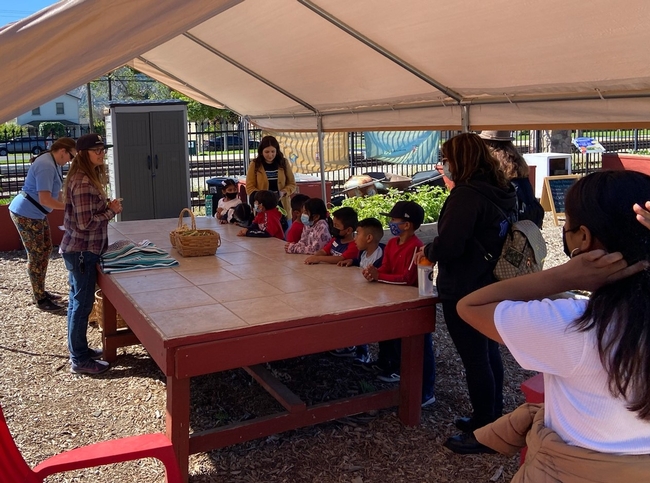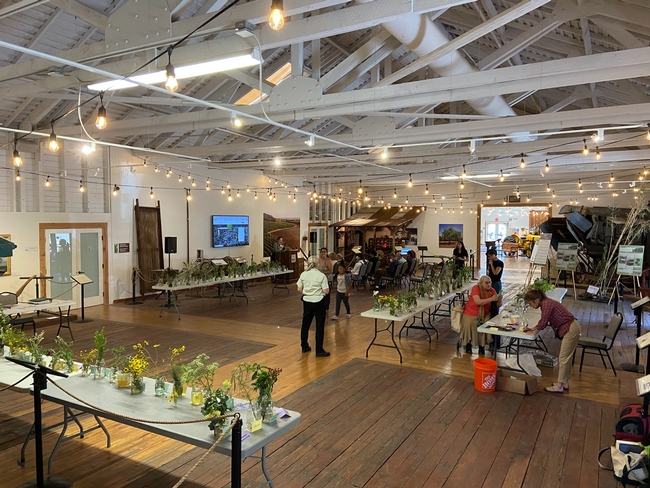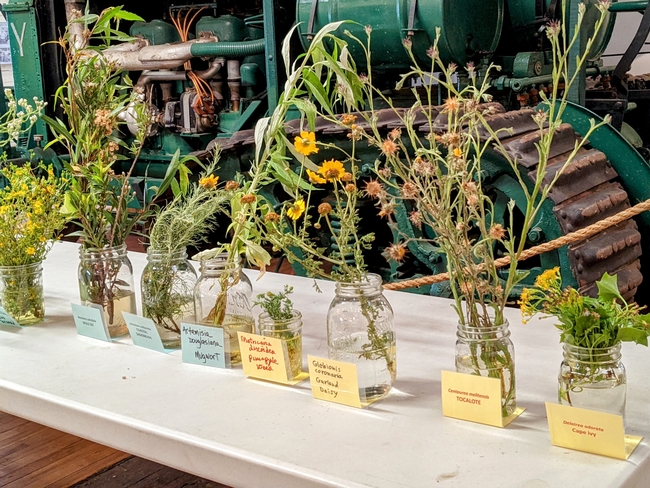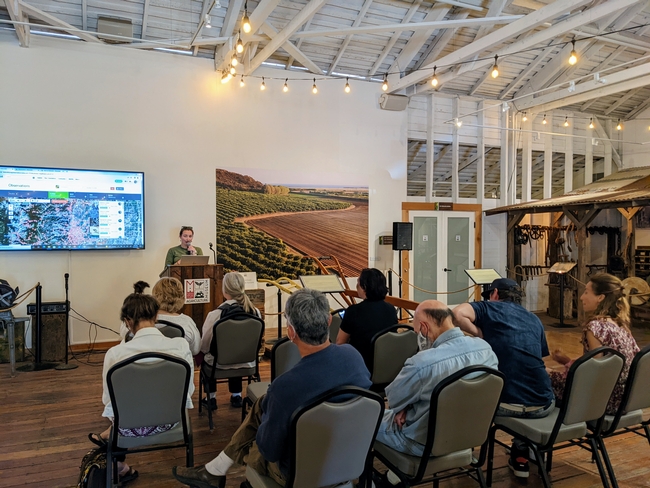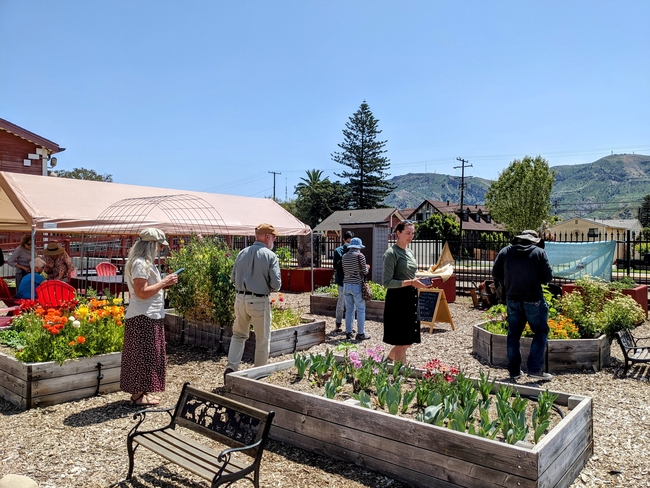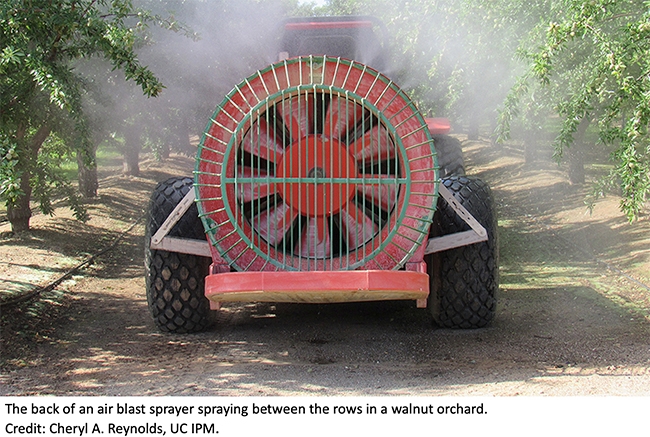By Julie Clark, Community Education Specialist III
Goldspotted borer (GSOB) is a beetle invasive to oaks in California. Infestations have ravaged oak woodlands in San Diego and Riverside counties the last 12 years and in Anaheim Hills, Angeles and San Bernardino National Forests the last few years. Preferred hosts are black oak, canyon oak, coast live oak, and occasionally Engelmann oak.
Oak woodlands are highly valued ecosystems that support numerous species of fauna. Oak trees serve as the anchor for these systems and support over 5000 insect species, over 105 bird species, 105 mammal species, 58 species of amphibians and reptiles during their respective life cycles. Many beneficial insects rely on oaks to complete their life cycles and do not damage the trees in doing so.
GSOB bore into the bark of its hosts to lay eggs and rear young. Mature beetles emerge to find new hosts. The adults leave a distinctive D-shape hole in the bark upon exit. 
The insects damage the water and food transfer structures (xylem and phloem) of the tree, causing crown die-back and eventual death in heavily infested (amplifier) trees. Widespread loss of oaks from GSOB has occurred in Idyllwild and San Diego County mountain areas.
Although GSOB are winged, they do not fly long distance. UC researchers, partners with CAL FIRE and the California Firewood Task Force discovered that several of the infestations throughout Southern California were caused by introduction of firewood imported from infestations in other areas. 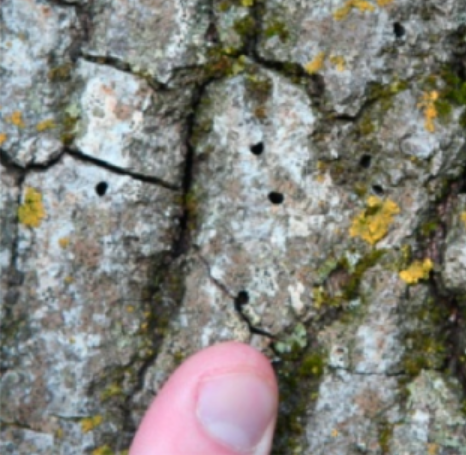
D-shaped GSOB exit holes. Credit: UC ANR
Ventura County is vulnerable to attack by the beetle and other invasive tree pests that are on watchlists for the area. Best ways of being assured your firewood is safe include purchasing locally source material or selecting kiln-dried or certified firewood.
For more information:
Report suspected GSOB infestation:
https://ucanr.edu/sites/gsobinfo/What_You_Can_Do/Report_GSOB_Symptoms/
- Author:
Julie D Clark De Blasio
UCCE Ventura collaborated in this first annual three-day event held at the Museum of Ventura - Agricultural Museum April 22-24. Ventura County Agricultural Commissioner/Weights & Measures (VC-AC/WM) initiated and directed the show, with cooperation from the museum, CE-Ven, Ventura County Master Gardeners (MG), Channel Islands Chapter - California Native Plant Society (CNPS), and Santa Barbara Botanical Garden (SBBG).
The family event included museum garden tours hosted by MG, a mason bee house construction activity by the Museum, iNaturalist participatory-science nature reporting led by SBBG, invasive weed posters created by VC-AC/WM, and the weed and wildflower show display coordinated by VC-AC/WM, CNPS, and CE-Ven.
Several hundred people attended the three-day event. One-hundred twenty weed and wildflower specimens were collected by CNPS and VC-AC/WM.
The maiden event is likely to become an annual springtime occurrence in Ventura County!
Author - Sabrina L. Drill
Kudos to the Ventura County Fire Department, Conejo Open Space Conservation Agency, National Park Service, US Forest Service, and California State Parks for addressing this very important gap in fire preparedness information. I remember on my first solo backpacking trip near Mt. Whitney waking up one morning to the smell of smoke, and cutting my trip a few nights short to get out of there (turned out the fire was in Monterey County, but the smoke blew inland).
From the guide - "The Ready, Set, Go! Trail Users program is about being prepared (ready), situational awareness – knowing what's going on around you (set) – and getting out of harm's way (go!). By following a few simple steps, trail users can enjoy the natural beauty of Ventura County without putting themselves in the path of a wildfire."
Tips include when, where, and how to safely have a campfire or use a stove, and steps to prepare before your trip: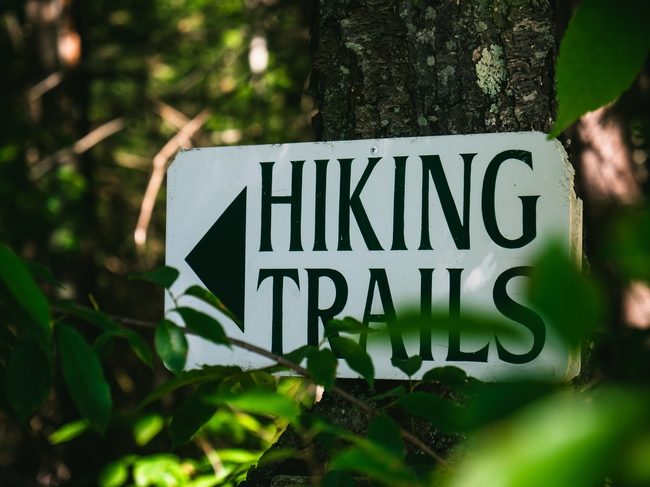
"• Before you leave, tell someone when and where you will be. This is especially important if you will be travelling alone. Be sure to take a fully charged cell phone and some sort of signaling device with you. This could be as simple as a whistle or a mirror. • Take protective clothing including long pants and long sleeves made of a natural fiber, a bandana to filter smoky air and a hat to keep embers from falling on your head. • Have good maps with you and pre-plan your escape routes. A fire could block your path and prevent you from going out the same way you came in."
- Author: Rose Marie Hayden-Smith
Invasive shot hole borers (ISHB) are tiny beetles that are posing a significant threat in Ventura County and beyond.
There's new information provided in a recent blog post that appeared on website of the Channel Islands Chapter of the Community Association Institute in January 2021. Wayne Farnsworth of
These pests are becoming established in parts of Ventura County. Farnsworth and Oliver note that "Unlike many insect pests, invasive shot hole borers infest a wide variety of tree species, including many common ornamentals, avocados and California natives. Sycamores and box elders are among their favorites, and they also attack live oaks, valley oaks and alders, all of which are abundant in our area."
Per UC ANR, invasive shot hole borers are
"two closely related species of small, non-native, beetles that bore into trees. ISHB introduce fungi that cause a tree disease called Fusarium dieback (FD). The ISHB-FD pest-disease complex is responsible for the death of thousands of trees in Southern California and poses an imminent threat to the integrity of our urban and natural forests.
Invasive shot hole borers attack a wide variety of tree species including avocados, common landscape selections, and California native species in urban and wildland environments."
You can learn more about ISHB at the UC ANR Integrated Pest Management website.
As Julie Di Blasio reported last year, "...invasive shot hole borer (ISHB) infestations have been identified in Ventura County since 2015 but have not significantly spread. Discovery of the pest/disease complex was found in late 2018 in the urban forest of Meiners Oaks. Citizens Journal recently published an article about the removal of a tree that was at risk for amplifying the local infestation and causing potential other community harm."
UCCE Ventura has been collaborating to address ISHB with UC insect, disease, education specialists, Ventura County Agricultural Commissioner, CAL FIRE, US Forest Service, several other agencies and non-government organizations. We are locally active in monitoring and outreach. Ventura County Master Gardeners Invasive Pests Outreach Group augments our work through their efforts to educate the public, firewood users and vendors."
Image credit: Akif Eskalen, UC Davis/UC ANR

- Author: Cheryl Reynolds
We're excited to announce that a brand-new online course on air blast spray calibration is now available. This course was developed by Lynn Wunderlich, University of California Cooperative Extension (UCCE) farm advisor for the Central Sierra, and Franz Niederholzer, UCCE farm advisor for Colusa, Sutter, and Yuba counties.
If you are a grower, pest control adviser, or pesticide applicator working in trees and vines, then this course is for you! You will learn the basic principles of spray calibration, take a close look at the basic components of a sprayer, perform calculations needed for calibration, and take a look at how factors such as droplet size, nozzle type, and weather conditions influence drift and spray coverage. This course also explains the conditions for pesticide applications under the 2018 Pesticide Use Near Schoolsites regulation. Air Blast Spray Calibration has been approved by DPR for a total of 2.5 continuing education units (CEUs), including 0.5 hour of Pesticide Laws and Regulations and 2.0 hours of Other.
Fall is here and 2020 is winding down; it's time to complete your continuing education units and submit your California Department of Pesticide Regulation (DPR) renewal packet. If you are a DPR license or certificate holder and your last name begins with the letters A through L, then 2020 is your year to renew. Renewing now guarantees a quick turnaround time and having enough time to resolve any problems before your license expires. DPR encourages all license holders to send in renewals November 1 to ensure license renewal by January 1, 2021. Why not check out the online courses the UC Statewide IPM Program (UC IPM) has to offer?
Four of UC IPM's most-wanted courses are offered at an early-bird price until November 1st! You can save an additional $20 by purchasing the 4-course bundle for only $85 rather than each course individually.
- Proper Pesticide Use to Avoid Illegal Residues (2 hours Laws and Regulations – early-bird price $40; full price $80)
- Proper Selection, Use, and Removal of Personal Protective Equipment (1.5 hours Laws and Regulations – early-bird price $30; full price $60)
- Pesticide Resistance (2 hours Other – early-bird price $20; full price $40)
- Pesticide Application Equipment and Calibration (1.5 hours Other – early-bird price $15; full price $30)
Many of our courses are now credited not only by DPR for continuing education hours, and also by the California Structural Pest Control Board (SPCB), Certified Crop Advisor (CCA), the Western Chapter of the International Society of Arboriculture (WCISA), and the Arizona Department of Agriculture.


